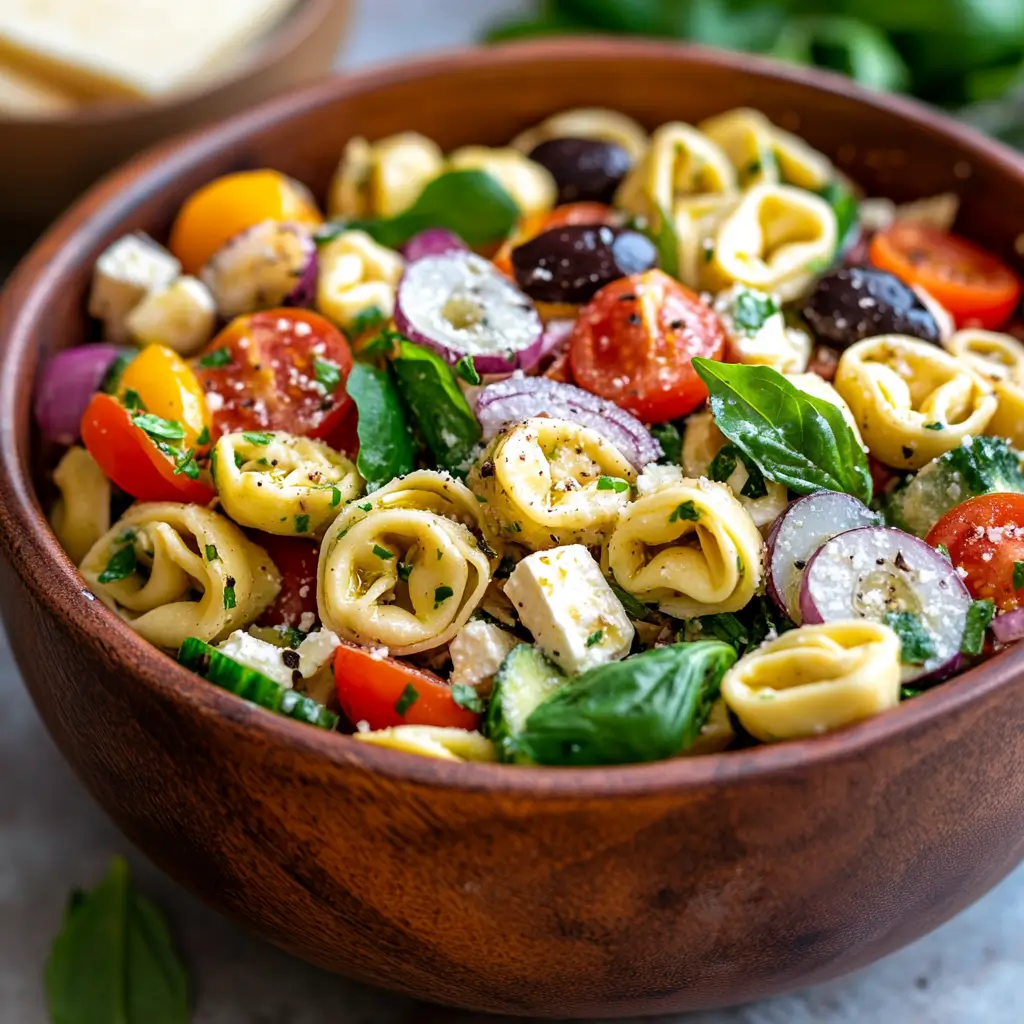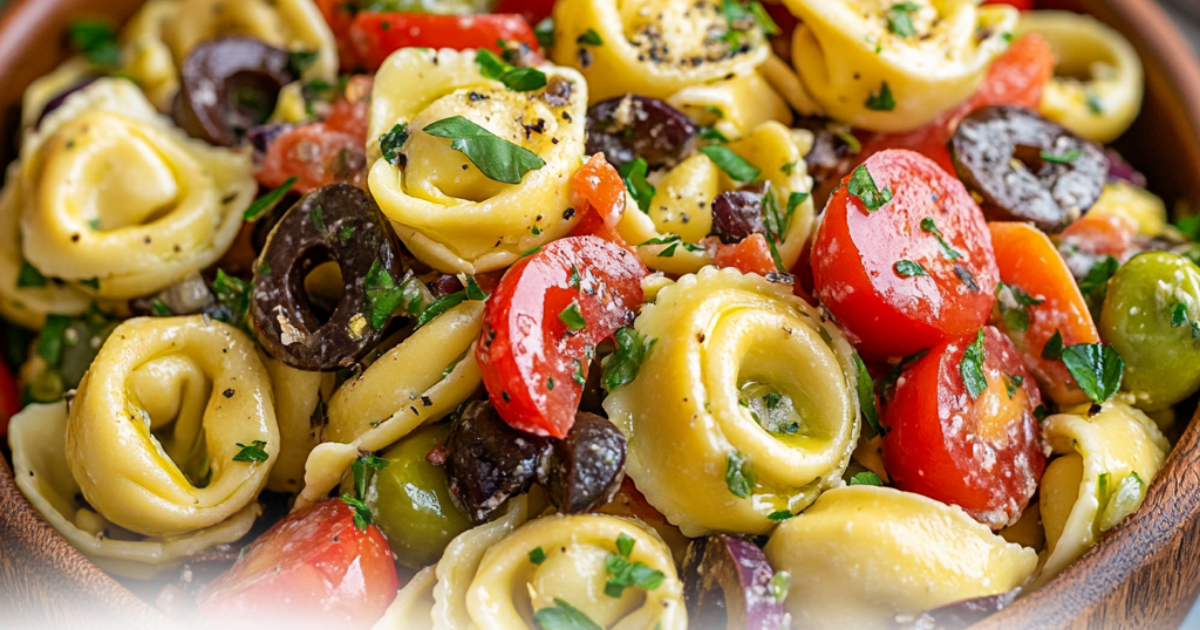In the realm of delightful, easy-to-prepare dishes, tortellini pasta salad holds a special place. Whether it’s whipped up for a sunny picnic or as a quick family dinner, its versatility and rich flavors make it a favorite. However, like all good things, tortellini pasta salad doesn’t last forever. This article delves into the pivotal question: How long does tortellini pasta salad last in the fridge? By understanding the optimal storage methods, the signs of spoilage, and techniques to extend its shelf life, you can ensure that every bite remains as delicious as the first.
Table of contents
Introduction to Tortellini Pasta Salad
Tortellini pasta salad, with its tender pockets of cheese or meat-filled pasta, tossed with a medley of crisp vegetables and robust dressings, is not just a dish but a celebration of textures and tastes. This guide will walk you through the essential storage techniques to keep your salad fresh and safe to eat.
Overview of Tortellini Pasta Salad
Tortellini pasta salad marries the rich flavors of traditional Italian pasta with the crisp, fresh elements of a classic salad. Whether served as a side dish or a main course, its culinary charm lies in its flexibility to incorporate a variety of ingredients and dressings—from creamy mayonnaise to tangy vinaigrettes. What Goes Well with Tortellini Pasta?

Importance of Proper Storage
Maintaining the freshness of tortellini pasta salad hinges significantly on how it is stored. Proper storage not only preserves its delightful flavors but also guards against the growth of bacteria that can lead to foodborne illnesses. Ensuring that the pasta salad remains at a safe temperature in the fridge is crucial for prolonging its edibility and enjoyment.
Storage Recommendations
Proper storage is crucial to extending the life of tortellini pasta salad, ensuring it remains tasty and safe to eat. Here, we’ll explore how to best keep this delicious dish fresh in your refrigerator.
Optimal Refrigeration Practices
To keep tortellini pasta salad at its best, refrigeration is key. The ideal scenario is to store the salad in an airtight container, which minimizes exposure to air and moisture—two factors that can hasten spoilage. Moreover, keeping the pasta salad at a consistent temperature of 40°F (4°C) or below is vital, as this reduces the risk of bacterial growth. Always remember to return the salad to the fridge immediately after serving to maintain this temperature threshold.
Guidelines for Freezing Tortellini Pasta Salad
Though not all pasta salads freeze well, particularly those with creamy dressings or added fresh vegetables, freezing can be a viable option for extending the shelf life of tortellini pasta salad. If you choose to freeze your pasta salad, do so in a freezer-safe container right after it has cooled down. This helps preserve the texture and flavor of the pasta and prevent ice crystal formation. However, it’s important to note that frozen pasta salad is best consumed within 1-2 months to maintain its quality. When ready to eat, thaw the pasta salad in the fridge overnight before serving to ensure it remains delicious and safe , How Many Calories Are in Philly Cheesesteak Pasta?
Factors Influencing Shelf Life
Understanding the elements that affect how long does tortellini pasta salad last in the fridge? is crucial for maximizing its freshness and edibility.
Impact of Ingredients on Freshness
The components of your tortellini pasta salad can significantly influence its shelf life. Ingredients like fresh vegetables and herbs tend to shorten the lifespan due to their moisture content, which can lead to quicker spoilage. Conversely, oil-based dressings can extend the life of pasta salad as they do not spoil as quickly as dairy-based or mayonnaise dressings. Therefore, choosing the right ingredients not only impacts the flavor but also how long the salad can be safely stored in the fridge.

The Role of Temperature and Container Type
Maintaining a constant, cool temperature is fundamental to keeping tortellini pasta salad fresh. The fridge should be set to maintain a temperature below 40°F (4°C), which helps slow down the growth of harmful bacteria. Additionally, the type of container used can also impact the shelf life. Opt for airtight, moisture-resistant containers to minimize air exposure and moisture ingress, which are prime contributors to spoilage. By controlling these factors, you can ensure that your tortellini pasta salad remains safe and enjoyable to eat for as long as possible.
Identifying Spoilage Signs
Detecting when tortellini pasta salad has gone bad is key to ensuring food safety. Below are the main indicators to watch for.
Visual and Olfactory Indicators of Bad Tortellini Pasta Salad
Spotting spoilage in tortellini pasta salad starts with your senses. Look for any unusual changes in color or appearance, such as mold or sliminess, which are clear signs that the salad is no longer safe to eat. Similarly, any unpleasant or sour odors are strong indications of spoilage. It’s best to err on the side of caution: if it looks or smells off, it’s time to discard it.
Health Risks of Consuming Spoiled Food
Consuming spoiled tortellini pasta salad can pose serious health risks, including food poisoning from bacteria like salmonella or E. coli. Symptoms can range from mild digestive discomfort to severe dehydration and require medical attention. Always prioritize safe storage and heed the shelf life of how long does tortellini pasta salad last in the fridge? to prevent these risks.
Creative Variations for Tortellini Pasta Salad
Expand the variety and appeal of tortellini pasta salad by exploring creative ingredient combinations and dressing options. Here are some popular variations to consider:
- Mediterranean Style: Incorporate ingredients like sun-dried tomatoes, Kalamata olives, feta cheese, and a drizzle of olive oil with oregano.
- Protein-Packed Option: Add shredded chicken, chickpeas, or grilled shrimp for a hearty twist.
- Vegetarian Delight: Toss with roasted vegetables like zucchini, bell peppers, and cherry tomatoes, complemented by a balsamic glaze.
These ideas not only keep the dish exciting but also allow for ingredient adjustments based on seasonality or dietary preferences.
The Science Behind Spoilage
Understanding the science of food spoilage can help you better manage the storage of tortellini pasta salad.
- Microbial Growth: Warm temperatures encourage the growth of bacteria like E. coli or Listeria. Keeping the salad at or below 40°F (4°C) slows this process.
- Moisture Content: Ingredients with high water content, such as cucumbers or tomatoes, can lead to quicker spoilage due to microbial activity. Use drier components or pat fresh vegetables dry before adding them.
This scientific insight can be useful for making informed decisions about food safety.
Repurposing Leftover Tortellini Pasta Salad
Got leftovers? Here are a few ways to give a second life to tortellini pasta salad:
- Tortellini Soup: Add the salad to a light chicken or vegetable broth for a quick and hearty soup.
- Warm Pasta Bake: Layer the salad with marinara sauce and cheese in a casserole dish, and bake until bubbly for a comforting meal.
- Refreshing Wraps: Use the salad as a filling for tortilla wraps or pita pockets, adding greens for extra crunch.
These ideas can reduce food waste while introducing variety to your meals.
Safety Tips for Serving Tortellini Pasta Salad
To ensure the salad remains safe to eat during gatherings:
- Use Ice Packs: If serving outdoors or at room temperature, keep the salad chilled with ice packs or in a cooler.
- Portion Control: Serve smaller portions and replenish from the fridge as needed to avoid prolonged exposure to warmer temperatures.
- Two-Hour Rule: Discard any pasta salad left out at room temperature for more than two hours.
These tips can prevent foodborne illnesses and help you enjoy the dish worry-free.
Eco-Friendly Storage Solutions
For those seeking sustainable options, consider these eco-friendly storage practices:
- Reusable Containers: Store the salad in glass or stainless steel containers with airtight lids.
- Beeswax Wraps: Use these as a sustainable alternative to plastic wrap for covering bowls.
- Compost Leftovers: If spoilage occurs, compost the spoiled salad instead of discarding it in the trash.
These small steps can minimize your environmental impact while keeping your food fresh.
Pairing Suggestions for Tortellini Pasta Salad
Elevate your dining experience by pairing tortellini pasta salad with complementary dishes:
- Light Protein: Serve alongside grilled salmon, lemon-herb chicken, or tofu skewers.
- Refreshing Beverages: Pair with iced tea, sparkling water infused with citrus, or a crisp white wine like Sauvignon Blanc.
- Desserts: Finish the meal with light options like fruit sorbet or panna cotta.
Extending Shelf Life
Extending the freshness of your tortellini pasta salad involves careful handling and some culinary tricks to keep it tasty and safe for a longer period.
Safe Handling and Hygiene Practices
Proper hygiene is crucial for extending the shelf life of tortellini pasta salad. Always start with clean hands and utensils and avoid cross-contamination with raw meats or other potential contaminants. This helps keep the salad safe from harmful bacteria that can cause spoilage.
Effective Use of Preservatives and Seasonings
Using natural preservatives like vinegar or lemon juice in your dressing can help slow bacterial growth and extend the freshness of your salad. Additionally, herbs and spices not only enhance flavor but also have natural antibacterial properties that contribute to longer shelf life. Incorporate these elements wisely to maintain the balance of flavors and safety in your pasta salad.
For more delicious and safe pasta dishes, consider exploring other recipes that focus on freshness and preservation on our recipe pages: How to Make the Perfect Greek Tortellini Pasta Salad
FAQs
Addressing frequently asked questions is a great way to cover common concerns about tortellini pasta salad storage and safety.
What is the maximum duration Tortellini Pasta Salad can stay fresh in the fridge?
The maximum duration that tortellini pasta salad can stay fresh in the fridge typically ranges from 3 to 5 days. This timeframe ensures that the flavors remain vibrant and the risk of bacterial growth is minimized. Always store the salad in an airtight container and keep your refrigerator temperature steady at or below 40°F (4°C).
Can Tortellini Pasta Salad be frozen to extend its shelf life?
Yes, tortellini pasta salad can be frozen to extend its shelf life, although the texture and flavor may change slightly upon thawing. Freezing is best for pasta salads with oil-based dressings rather than mayonnaise or dairy-based ones. To freeze, place the salad in a freezer-safe container or bag and use within 1-2 months for optimal quality. Thaw in the refrigerator before serving to maintain safety and taste.
Conclusion and Best Practices
In wrapping up, understanding how long does tortellini pasta salad last in the fridge? and how to properly store it can greatly impact not just the safety but also the enjoyment of your meal.
Recap of Key Points
To ensure the longevity and safety of your tortellini pasta salad, remember to store it promptly in the fridge at a consistent and cool temperature, use airtight containers, and be mindful of the initial freshness of your ingredients. Observing these practices will help maintain the quality and safety of your pasta salad.
Final Recommendations for Tortellini Pasta Salad Storage
For optimal results, consume your tortellini pasta salad within 3 to 5 days of preparation, and consider the type of dressing and ingredients used to best judge its shelf life. If ever in doubt, err on the side of caution and discard any pasta salad that shows signs of spoilage.

